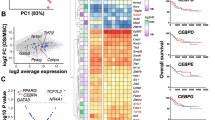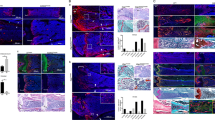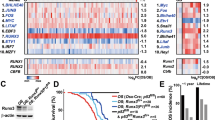Abstract
Osteoblast differentiation is achieved by activating a transcriptional network in which Dlx5, Runx2 and Osx/SP7 have fundamental roles. The tumour suppressor p53 exerts a repressive effect on bone development and remodelling through an unknown mechanism that inhibits the osteoblast differentiation programme. Here we report a physical and functional interaction between Osx and p53 gene products. Physical interaction was found between overexpressed proteins and involved a region adjacent to the OSX zinc fingers and the DNA-binding domain of p53. This interaction results in a p53-mediated repression of OSX transcriptional activity leading to a downregulation of the osteogenic programme. Moreover, we show that p53 is also able to repress key osteoblastic genes in Runx2-deficient osteoblasts. The ability of p53 to suppress osteogenesis is independent of its DNA recognition ability but requires a native conformation of p53, as a conformational missense mutant failed to inhibit OSX. Our data further demonstrates that p53 inhibits OSX binding to their responsive Sp1/GC-rich sites in the promoters of their osteogenic target genes, such as IBSP or COL1A1. Moreover, p53 interaction to OSX sequesters OSX from binding to DLX5. This competition blocks the ability of OSX to act as a cofactor of DLX5 to activate homeodomain-containing promoters. Altogether, our data support a model wherein p53 represses OSX–DNA binding and DLX5–OSX interaction, and thereby deregulates the osteogenic transcriptional network. This mechanism might have relevant roles in bone pathologies associated to osteosarcomas and ageing.
Similar content being viewed by others
Log in or create a free account to read this content
Gain free access to this article, as well as selected content from this journal and more on nature.com
or
References
Long F . Building strong bones: molecular regulation of the osteoblast lineage. Nat Rev Mol Cell Biol 2011; 13: 27–38.
Karsenty G, Kronenberg HM, Settembre C . Genetic control of bone formation. Annu Rev Cell Dev Biol 2009; 25: 629–648.
Sinha KM, Zhou X . Genetic and molecular control of osterix in skeletal formation. J Cell Biochem 2013; 114: 975–984.
Ducy P, Zhang R, Geoffroy V, Ridall AL, Karsenty G . Osf2/Cbfa1: a transcriptional activator of osteoblast differentiation. Cell 1997; 89: 747–754.
Zhou X, Zhang Z, Feng JQ, Dusevich VM, Sinha K, Zhang H et al. Multiple functions of Osterix are required for bone growth and homeostasis in postnatal mice. Proc Natl Acad Sci USA 2010; 107: 12919–12924.
Baek WY, de Crombrugghe B, Kim JE . Postnatally induced inactivation of Osterix in osteoblasts results in the reduction of bone formation and maintenance. Bone 2010; 46: 920–928.
Timpson NJ, Tobias JH, Richards JB, Soranzo N, Duncan EL, Sims AM et al. Common variants in the region around Osterix are associated with bone mineral density and growth in childhood. Hum Mol Genet 2009; 18: 1510–1517.
Lapunzina P, Aglan M, Temtamy S, Caparros-Martin JA, Valencia M, Leton R et al. Identification of a frameshift mutation in Osterix in a patient with recessive osteogenesis imperfecta. Am J Hum Genet 2010; 87: 110–114.
Artigas N, Urena C, Rodriguez-Carballo E, Rosa JL, Ventura F . Mitogen-activated protein kinase (MAPK)-regulated interactions between Osterix and Runx2 are critical for the transcriptional osteogenic program. J Biol Chem 2014; 289: 27105–27117.
Hojo H, Ohba S, He X, Lai LP, McMahon AP . Sp7/osterix is restricted to bone-forming vertebrates where it acts as a Dlx co-factor in osteoblast specification. Dev Cell 2016; 37: 238–253.
Ulsamer A, Ortuno MJ, Ruiz S, Susperregui AR, Osses N, Rosa JL et al. BMP-2 induces Osterix expression through up-regulation of Dlx5 and its phosphorylation by p38. J Biol Chem 2008; 283: 3816–3826.
Ortuno MJ, Ruiz-Gaspa S, Rodriguez-Carballo E, Susperregui AR, Bartrons R, Rosa JL et al. p38 regulates expression of osteoblast-specific genes by phosphorylation of osterix. J Biol Chem 2010; 285: 31985–31994.
Greenblatt MB, Shim JH, Zou W, Sitara D, Schweitzer M, Hu D et al. The p38 MAPK pathway is essential for skeletogenesis and bone homeostasis in mice. J Clin Invest 2010; 120: 2457–2473.
Carvajal LA, Manfredi JJ . Another fork in the road—life or death decisions by the tumour suppressor p53. EMBO Rep 2013; 14: 414–421.
Molchadsky A, Shats I, Goldfinger N, Pevsner-Fischer M, Olson M, Rinon A et al. p53 plays a role in mesenchymal differentiation programs, in a cell fate dependent manner. PLoS ONE 2008; 3: e3707.
Liu H, Jia D, Li A, Chau J, He D, Ruan X et al. p53 regulates neural stem cell proliferation and differentiation via BMP-Smad1 signaling and Id1. Stem Cells Dev 2013; 22: 913–927.
Wang X, Kua HY, Hu Y, Guo K, Zeng Q, Wu Q et al. p53 functions as a negative regulator of osteoblastogenesis, osteoblast-dependent osteoclastogenesis, and bone remodeling. J Cell Biol 2006; 172: 115–125.
Armstrong JF, Kaufman MH, Harrison DJ, Clarke AR . High-frequency developmental abnormalities in p53-deficient mice. Curr Biol 1995; 5: 931–936.
He Y, de Castro LF, Shin MH, Dubois W, Yang HH, Jiang S et al. p53 loss increases the osteogenic differentiation of bone marrow stromal cells. Stem Cells 2015; 33: 1304–1319.
Ruan X, Zuo Q, Jia H, Chau J, Lin J, Ao J et al. P53 deficiency-induced Smad1 upregulation suppresses tumorigenesis and causes chemoresistance in colorectal cancers. J Mol Cell Biol 2015; 7: 105–118.
Liu W, Qi M, Konermann A, Zhang L, Jin F, Jin Y . The p53/miR-17/Smurf1 pathway mediates skeletal deformities in an age-related model via inhibiting the function of mesenchymal stem cells. Aging (Albany NY) 2015; 7: 205–218.
Ozaki T, Wu D, Sugimoto H, Nagase H, Nakagawara A . Runt-related transcription factor 2 (RUNX2) inhibits p53-dependent apoptosis through the collaboration with HDAC6 in response to DNA damage. Cell Death Dis 2013; 4: e610.
van der Deen M, Taipaleenmaki H, Zhang Y, Teplyuk NM, Gupta A, Cinghu S et al. MicroRNA-34c inversely couples the biological functions of the runt-related transcription factor RUNX2 and the tumor suppressor p53 in osteosarcoma. J Biol Chem 2013; 288: 21307–21319.
Lengner CJ, Steinman HA, Gagnon J, Smith TW, Henderson JE, Kream BE et al. Osteoblast differentiation and skeletal development are regulated by Mdm2-p53 signaling. J Cell Biol 2006; 172: 909–921.
Nakashima K, Zhou X, Kunkel G, Zhang Z, Deng JM, Behringer RR et al. The novel zinc finger-containing transcription factor osterix is required for osteoblast differentiation and bone formation. Cell 2002; 108: 17–29.
Ortuno MJ, Susperregui AR, Artigas N, Rosa JL, Ventura F . Osterix induces Col1a1 gene expression through binding to Sp1 sites in the bone enhancer and proximal promoter regions. Bone 2013; 52: 548–556.
Yang Y, Huang Y, Zhang L, Zhang C . Transcriptional regulation of bone sialoprotein gene expression by Osx. Biochem Biophys Res Commun 2016; 476: 574–579.
Chen H, Hays E, Liboon J, Neely C, Kolman K, Chandar N . Osteocalcin gene expression is regulated by wild-type p53. Calcif Tissue Int 2011; 89: 411–418.
Chen H, Kolman K, Lanciloti N, Nerney M, Hays E, Robson C et al. p53 and MDM2 are involved in the regulation of osteocalcin gene expression. Exp Cell Res 2012; 318: 867–876.
Chau JF, Jia D, Wang Z, Liu Z, Hu Y, Zhang X et al. A crucial role for bone morphogenetic protein-Smad1 signalling in the DNA damage response. Nat Commun 2012; 3: 836.
Barbuto R, Mitchell J . Regulation of the osterix (Osx, Sp7) promoter by osterix and its inhibition by parathyroid hormone. J Mol Endocrinol 2013; 51: 99–108.
Lee KS, Kim HJ, Li QL, Chi XZ, Ueta C, Komori T et al. Runx2 is a common target of transforming growth factor beta1 and bone morphogenetic protein 2, and cooperation between Runx2 and Smad5 induces osteoblast-specific gene expression in the pluripotent mesenchymal precursor cell line C2C12. Mol Cell Biol 2000; 20: 8783–8792.
de Vries A, Flores ER, Miranda B, Hsieh HM, van Oostrom CT, Sage J et al. Targeted point mutations of p53 lead to dominant-negative inhibition of wild-type p53 function. Proc Natl Acad Sci USA 2002; 99: 2948–2953.
Chen Y, Dey R, Chen L . Crystal structure of the p53 core domain bound to a full consensus site as a self-assembled tetramer. Structure 2010; 18: 246–256.
Cho Y, Gorina S, Jeffrey PD, Pavletich NP . Crystal structure of a p53 tumor suppressor-DNA complex: understanding tumorigenic mutations. Science 1994; 265: 346–355.
Kruiswijk F, Labuschagne CF, Vousden KH . p53 in survival, death and metabolic health: a lifeguard with a licence to kill. Nat Rev Mol Cell Biol 2015; 16: 393–405.
Lee DF, Su J, Kim HS, Chang B, Papatsenko D, Zhao R et al. Modeling familial cancer with induced pluripotent stem cells. Cell 2015; 161: 240–254.
Balboni AL, Cherukuri P, Ung M, DeCastro AJ, Cheng C, DiRenzo J . p53 and DeltaNp63alpha coregulate the transcriptional and cellular response to TGFbeta and BMP signals. Mol Cancer Res 2015; 13: 732–742.
De Rosa L, Antonini D, Ferone G, Russo MT, Yu PB, Han R et al. p63 Suppresses non-epidermal lineage markers in a bone morphogenetic protein-dependent manner via repression of Smad7. J Biol Chem 2009; 284: 30574–30582.
Roca H, Phimphilai M, Gopalakrishnan R, Xiao G, Franceschi RT . Cooperative interactions between RUNX2 and homeodomain protein-binding sites are critical for the osteoblast-specific expression of the bone sialoprotein gene. J Biol Chem 2005; 280: 30845–30855.
Lee MH, Kim YJ, Yoon WJ, Kim JI, Kim BG, Hwang YS et al. Dlx5 specifically regulates Runx2 type II expression by binding to homeodomain-response elements in the Runx2 distal promoter. J Biol Chem 2005; 280: 35579–35587.
Nishio Y, Dong Y, Paris M, O'Keefe RJ, Schwarz EM, Drissi H . Runx2-mediated regulation of the zinc finger Osterix/Sp7 gene. Gene 2006; 372: 62–70.
Kawane T, Komori H, Liu W, Moriishi T, Miyazaki T, Mori M et al. Dlx5 and mef2 regulate a novel runx2 enhancer for osteoblast-specific expression. J Bone Miner Res 2014; 29: 1960–1969.
Muller PA, Vousden KH . p53 mutations in cancer. Nat Cell Biol 2013; 15: 2–8.
Vijayakumaran R, Tan KH, Miranda PJ, Haupt S, Haupt Y . Regulation of mutant p53 protein expression. Front Oncol 2015; 5: 284.
Sui B, Hu C, Liao L, Chen Y, Zhang X, Fu X et al. Mesenchymal progenitors in osteopenias of diverse pathologies: differential characteristics in the common shift from osteoblastogenesis to adipogenesis. Sci Rep 2016; 6: 30186.
Despars G, Carbonneau CL, Bardeau P, Coutu DL, Beausejour CM . Loss of the osteogenic differentiation potential during senescence is limited to bone progenitor cells and is dependent on p53. PLoS ONE 2013; 8: e73206.
Velletri T, Xie N, Wang Y, Huang Y, Yang Q, Chen X et al. P53 functional abnormality in mesenchymal stem cells promotes osteosarcoma development. Cell Death Dis 2016; 7: e2015.
Quist T, Jin H, Zhu JF, Smith-Fry K, Capecchi MR, Jones KB . The impact of osteoblastic differentiation on osteosarcomagenesis in the mouse. Oncogene 2015; 34: 4278–4284.
Tang N, Song WX, Luo J, Haydon RC, He TC . Osteosarcoma development and stem cell differentiation. Clin Orthop Relat Res 2008; 466: 2114–2130.
Walkley CR, Qudsi R, Sankaran VG, Perry JA, Gostissa M, Roth SI et al. Conditional mouse osteosarcoma, dependent on p53 loss and potentiated by loss of Rb, mimics the human disease. Genes Dev 2008; 22: 1662–1676.
Muller PA, Vousden KH . Mutant p53 in cancer: new functions and therapeutic opportunities. Cancer Cell 2014; 25: 304–317.
Kim MP, Zhang Y, Lozano G . Mutant p53: multiple mechanisms define biologic activity in cancer. Front Oncol 2015; 5: 249.
Rodriguez-Carballo E, Ulsamer A, Susperregui AR, Manzanares-Cespedes C, Sanchez-Garcia E, Bartrons R et al. Conserved regulatory motifs in osteogenic gene promoters integrate cooperative effects of canonical Wnt and BMP pathways. J Bone Miner Res 2011; 26: 718–729.
Gamez B, Rodriguez-Carballo E, Graupera M, Rosa JL, Ventura F . Class I PI-3-kinase signaling is critical for bone formation through regulation of SMAD1 activity in osteoblasts. J Bone Miner Res 2016; 31: 1617–1630.
Ran FA, Hsu PD, Wright J, Agarwala V, Scott DA, Zhang F . Genome engineering using the CRISPR-Cas9 system. Nat Protoc 2013; 8: 2281–2308.
Kitamura T, Koshino Y, Shibata F, Oki T, Nakajima H, Nosaka T et al. Retrovirus-mediated gene transfer and expression cloning: powerful tools in functional genomics. Exp Hematol 2003; 31: 1007–1014.
Junk DJ, Vrba L, Watts GS, Oshiro MM, Martinez JD, Futscher BW . Different mutant/wild-type p53 combinations cause a spectrum of increased invasive potential in nonmalignant immortalized human mammary epithelial cells. Neoplasia 2008; 10: 450–461.
Acknowledgements
We thank Drs B de Crombrugghe, J Martín-Caballero, M Montencino, Y-Xiong and HM Ryoo for reagents. We also thank E Adanero, E Castaño and B Torrejón for technical assistance. Natalia Artigas is the recipient of a fellowship from University of Barcelona. This research was supported by grants from the M.E.C. (BFU2014-56313-P) and La Marató de TV3.
Author information
Authors and Affiliations
Corresponding author
Ethics declarations
Competing interests
The authors declare no conflict of interest.
Additional information
Edited by S Fulda
Supplementary Information accompanies this paper on Cell Death and Differentiation website
Supplementary information
Rights and permissions
About this article
Cite this article
Artigas, N., Gámez, B., Cubillos-Rojas, M. et al. p53 inhibits SP7/Osterix activity in the transcriptional program of osteoblast differentiation. Cell Death Differ 24, 2022–2031 (2017). https://doi.org/10.1038/cdd.2017.113
Received:
Revised:
Accepted:
Published:
Issue date:
DOI: https://doi.org/10.1038/cdd.2017.113
This article is cited by
-
Fam102a translocates Runx2 and Rbpjl to facilitate Osterix expression and bone formation
Nature Communications (2025)
-
Nuclear farnesoid X receptor protects against bone loss by driving osteoblast differentiation through stabilizing RUNX2
Bone Research (2025)
-
Aged mesenchymal stem cells and inflammation: from pathology to potential therapeutic strategies
Biology Direct (2023)
-
Mesenchymal stem cells under epigenetic control – the role of epigenetic machinery in fate decision and functional properties
Cell Death & Disease (2023)
-
Japanese medaka Olpax6.1 mutant as a potential model for spondylo-ocular syndrome
Functional & Integrative Genomics (2023)



